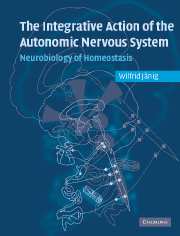Book contents
- Frontmatter
- Contents
- Foreword
- Preface
- List of abbreviations
- Introduction
- Part I The autonomic nervous system: functional anatomy and visceral afferents
- Part II Functional organization of the peripheral autonomic nervous system
- Part III Transmission of signals in the peripheral autonomic nervous system
- Part IV Central representation of the autonomic nervous system in spinal cord, brain stem and hypothalamus
- Chapter 8 Anatomy of central autonomic systems
- Chapter 9 Spinal autonomic systems
- Chapter 10 Regulation of organ systems by the lower brain stem
- Chapter 11 Integration of autonomic regulation in upper brain stem and limbic-hypothalamic centers: a summary
- References
- Index
Chapter 11 - Integration of autonomic regulation in upper brain stem and limbic-hypothalamic centers: a summary
Published online by Cambridge University Press: 10 August 2009
- Frontmatter
- Contents
- Foreword
- Preface
- List of abbreviations
- Introduction
- Part I The autonomic nervous system: functional anatomy and visceral afferents
- Part II Functional organization of the peripheral autonomic nervous system
- Part III Transmission of signals in the peripheral autonomic nervous system
- Part IV Central representation of the autonomic nervous system in spinal cord, brain stem and hypothalamus
- Chapter 8 Anatomy of central autonomic systems
- Chapter 9 Spinal autonomic systems
- Chapter 10 Regulation of organ systems by the lower brain stem
- Chapter 11 Integration of autonomic regulation in upper brain stem and limbic-hypothalamic centers: a summary
- References
- Index
Summary
The final chapter will describe how integrative neural control of most body functions is vital to keep the body able to survive and act in its environment. The autonomic nervous system is involved in virtually all of these functions (see Tables 11.1 and 11.2). I want to make clear:
that the power and range of this integrative control of body function in mammals are dependent on the mesencephalon, hypothalamus and cerebral hemispheres;
that the mastermind of the integration of autonomic, somatomotor and endocrine systems is located in the telencephalon;
that the functionally differentiated autonomic pathways are the slaves of this mastermind, and
that the “wisdom of the body” is to be found within these regions of the brain.
I will strictly adhere to the autonomic systems, described in the preceding chapters, in this description and will emphasize some critical points. I do not intend to describe the mechanisms underlying these integrative control systems in detail (as this would require another book). The chapter will not cover (1) how stress involves the autonomic nervous system in body protection (see Goldstein [1995, 2000]; Chrousos [1998]; McEwen [2001a]) and (2) neural mechanisms underlying emotional and motivational processes (Le Doux 1996; Panksepp 1998; Davidson et al. 2003; Morris and Dolan 2004).
The chapter will start with some critical reflections on concepts about the functioning of the autonomic nervous system that were propagated by Walter Bradford Cannon and Walter Rudolf Hess and are still influential in physiology and medicine.
- Type
- Chapter
- Information
- Integrative Action of the Autonomic Nervous SystemNeurobiology of Homeostasis, pp. 459 - 518Publisher: Cambridge University PressPrint publication year: 2006
- 1
- Cited by



